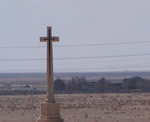North African Campaign
Key dates
- 13 September 1940:
Italian forces invade Egypt. - 9 December 1940:
First Western Desert offensive begins. Some New Zealand support troops are involved. - 18 November 1941:
Operation Crusader to relieve Tobruk begins. - 1 July 1942:
First battle of El Alamein begins. - 23 October 1942:
Second battle of El Alamein begins. - 13 May 1943:
German and Italian forces in North Africa surrender.
See also: North Africa Campaign timeline
NZ Casualties
- 2989 dead
- 7000 wounded
- 4041 prisoners of war
Overview
Lasting from 1940 to 1943, North Africa was the longest and most important land campaign fought by New Zealanders in the Second World War. Forces from the United Kingdom, the Commonwealth and the British Empire, together with contingents from enemy-occupied European states, and in the later stages the United States, battled against those of Italy and Germany.
New Zealanders were involved in this struggle for three main reasons. First, they were in the area when the campaign opened. This was the First Echelon of the 2nd New Zealand Expeditionary Force (2NZEF), the force New Zealand had raised after its declaration of war on Germany on 3 September 1939. Second, Germany's blitzkrieg that led to its occupation of France and the Low Countries in May–June 1940 removed the possibility of 2NZEF reaching its intended destination, the Western Front. Finally, Italian dictator Benito Mussolini's decision in June 1940 to throw in his lot with Hitler seriously jeopardised the British position in Egypt. Immense concentrations of Italian forces in Libya and Abyssinia dwarfed the 36,000 British troops in the region. This threat became real when Italian forces crossed the Libyan border into Egypt in September 1940.
For the bulk of the New Zealanders, the main focus was ‘the Div'—the 16,000-strong 2 New Zealand Division commanded by First World War Victoria Cross winner Bernard (‘Tiny') Freyberg, who also commanded 2NZEF. Composed initially of volunteers, it formed the main fighting element of 2NZEF.
Setting
When the First Echelon arrived in Egypt on February 1940, they were in the curious situation of being stationed and engaging in hostilities in a country that was neutral, for Egypt did not declare war on Germany until 1945.
A camp was established on the outskirts of Maadi — twelve kilometres south of central Cairo. A subsidiary camp was established at Helwan, twelve kilometres further south. A railway line linked both these camps to Cairo.

Infantry training: waiting for the order to advance.
Alexander Turnbull Library, War History Collection, DA-02134
Until late in 1942, the division saw action in the western part of Egypt, with several forays into Libya. The physical challenge of the desert was immense. Nights could be cold but daytime temperatures soared, especially in summer. In the forward positions during daytime soldiers lying in slit trenches endured agony in the searing heat; shade was makeshift and invariably inadequate. Sandstorms were a trial, and fine dust stirred up by vehicles and shellfire got in everywhere. The lack of water to drink, let alone to wash or shave in, is something everyone remembers.
So are the flies. Desperate for moisture, these settled on lips or sweaty shirts by the hundreds. During daylight hours men struggled to eat as flies swarmed on their food or dived into their drinks. One inevitable result was dysentery, a miserable experience. Mosquitoes were less prevalent but more lethal, for in some areas they carried malaria. Adding to the men's misery were desert sores—any scratch rapidly became a suppurating mess. Everyone, it seemed, sported bandages.
Initially the campaign was fought between Commonwealth forces and Italians. The ‘Ities' were not a redoubtable foe. Some units were efficient and effective, and fought well, but in general the Italians were badly equipped and poorly led. Many of the troops were ambivalent about fighting on the German side, and unwilling to give their lives for a cause in which they did not believe.
In February 1941, the first elements of the German Africa Corps (Deutsches Afrika Korps) arrived to bolster the Italians, then reeling from a series of Allied blows. Commanded by General Erwin Rommel, an officer whose bold tactics were well suited to the conditions of desert warfare, this small force soon made its mark in the campaign.
Operation Crusader
New Zealanders were only marginally involved in the initial British operations that threw the Italians out of Egypt late in 1940 and went on to inflict a humiliating defeat on them at Beda Fomm, near the El Agheila gateway. In early 1941 New Zealanders served in British air and naval units and on the cruiser Leander as the Allies removed the Italian threat in Abyssinia. At the same time, two developments further north ensured that the North African campaign would be prolonged. German units began landing in Tripoli, and the New Zealand Division formed part of the expeditionary force sent to Greece in March.
While Allied attention was focused on Greece, Rommel had transformed the situation in Africa. Driving east from El Agheila, he forced the Allies back. Their retreat did not stop until they reached Egypt, leaving only Tobruk in Allied hands. Several unsuccessful Allied attempts to relieve it were made in the middle of 1941. A further attempt by 8 Army in November provided the setting for the New Zealanders' first foray into the desert in force.
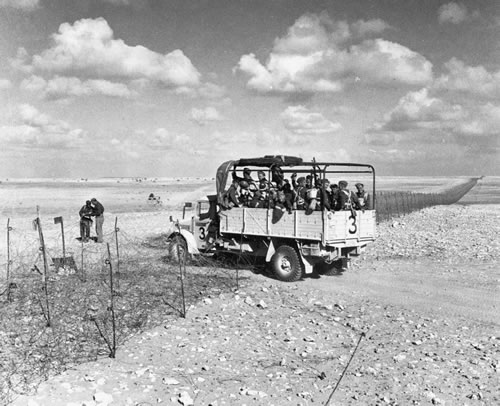
Going through the wire into Libya, November 1941.
Alexander Turnbull Library, War History Collection, DA-01637
Operation Crusader was a victory of sorts, although tactically Rommel prevailed. He smashed the British armour and inflicted heavy losses on the infantry in front of Tobruk, but in the end, conscious of his weakened state and supply problems, he pulled back to El Agheila, leaving the battlefield to the battered Allies. The British relieved Tobruk and headed westwards in pursuit. By 24 December Benghazi was back in Allied hands.
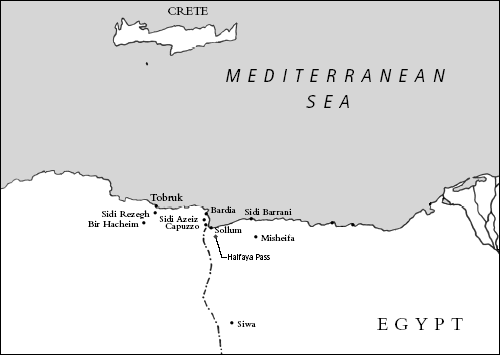
It was to relieve Allied troops at Tobruk that New Zealanders took part in Operation Crusader in November 1941.
Freyberg's men had fought well in their first desert battle. During the tank clash further south, the New Zealanders had advanced to relieve Tobruk, making progress despite strong opposition. At Point 175, 25 Battalion incurred the worst casualties suffered by a New Zealand battalion in a single day during the whole war. Rommel, after an injudicious dash towards the Libyan–Egyptian border to relieve Axis posts still holding out there, came racing from the south-west to the scene of action, overrunning a New Zealand brigade headquarters in the process. Several New Zealand battalions fell victim to his tanks, suffering heavy casualties on escarpments at Sidi Rezegh and Belhamed. For the third time that year New Zealanders went into captivity in their thousands — but unlike those captured in Greece, who were taken to Germany, these men were destined for camps in Italy after a dangerous trip across the Mediterranean.
In the aftermath of Crusader, the New Zealanders licked their wounds back in Egypt. With 879 dead and 1700 wounded, the division had fought its most costly battle of the war. In February 1942, at the New Zealand government's insistence, the Div moved to Syria to recover.
Minqar Qa'im
New Zealanders enjoyed the change of scene, but Rommel was busy. He had wasted no time in returning to the offensive, and again put the Allies on the back foot. In May Italian and German forces broke through at Gazala and, in contrast to the previous year, rapidly captured Tobruk. As this situation developed, the New Zealand Division was recalled from Syria and travelled quickly back to the Western Desert.
The New Zealanders took up defensive positions at Mersa Matruh, but soon sought a more mobile role further south. Within days oncoming German forces virtually encircled them at Minqar Qa'im. The only chance of salvation lay in a breakout through the ring of German forces blocking the way eastwards. Led by 4 Brigade, the troops burst into the enemy positions in a brutally efficient silent attack in the early hours of 28 June 1942. The New Zealanders used their bayonets to telling effect in the hand-to-hand fighting that ensued. As the attack proceeded, much of the rest of the division slipped through a gap further south.
Battles of El Alamein
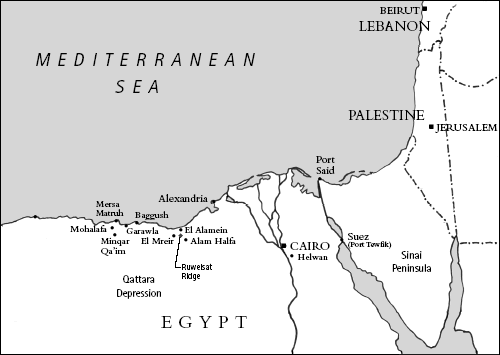
Map showing area where the two battles of El Alamein were fought
El Alamein cemetery and railway station, 2002
Over 1100 New Zealanders are buried in the El Alamein cemetery, filmed here by Megan Hutching during the 60th anniversary commemorations in 2002. Another 859 New Zealand names appear on the Alamein Memorial to the Missing (pictured).
![]() View
film clip (Windows Media Player, 1mb).
View
film clip (Windows Media Player, 1mb).
The New Zealand Division fell back to the Alamein Line, where it took part in the first Battle of Alamein. At Ruweisat on 15 July, and El Mreir a week later, the New Zealanders carried out their part of the attack plans by seizing their objectives in successful night assaults. Both times the infantry battalions were left unsupported on their objectives, and when German tanks appeared they had no choice but to surrender.
The inability of New Zealand anti-tank and other support weapons to get forward to the newly won positions contributed to the débâcle at Ruweisat. But its main cause was the failure of the British armour to move forward. Faulty command and staff work and a lack of initiative on the part of the exhausted British tankies lay at the heart of the problem. Two New Zealand brigades suffered heavy casualties in these battles, and several thousand more were taken prisoner.
Conscious that time was not on his side, Rommel tried to break the stalemate on the Alamein Line. This action marked the debut of a new commander of 8 Army, Lieutenant-General Bernard Montgomery. Montgomery was fortunate to arrive on the scene as conditions began to favour the Allies. But Montgomery was not just a lucky general. He brought a new uncompromising approach, immediately indicating that there would be no thought of further retreat.
In the second Battle of El Alamein, which began on 23 October 1942, the New Zealand Division had a key role. With South African, Australian and Scottish divisions, it would ‘break in' to the enemy defences, which were now covered by deep minefields. The violence of the opening barrage is still remembered for lighting up the sky like fireworks on Guy Fawkes' night. The New Zealanders seized their objectives on Miteiriya Ridge.
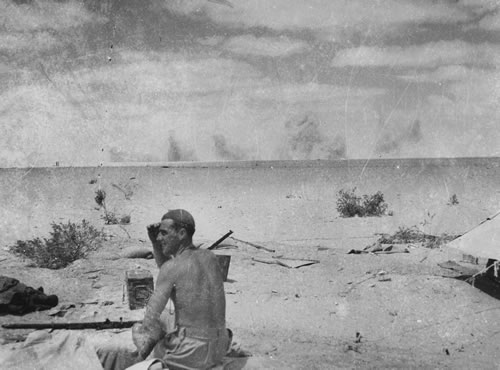
Shells bursting on the horizon at El Alamein, 1942.
Alexander Turnbull Library, War History Collection, PAColl-5547-057
The battle did not develop as Montgomery expected because the armour became bogged down. He planned a new attack further south: Operation Supercharge would essentially repeat the process of the initial attack. Although he looked to the New Zealand Division's experienced headquarters to plan Supercharge, the division itself was too weak to provide the punch necessary so two British brigades helped carry out the attack. New Zealand infantry battalions would protect the flanks while other divisional units advanced with the British infantry.
Operation Supercharge began at 1.05 a.m. on 2 November. By 4 November Rommel was withdrawing the mobile parts of his army. Many of the Italian troops, without adequate transport, were taken prisoner. Rommel felt that the Axis loss at Alamein was decisive. For the time being, however, he conducted a skilful retreat.
Anglo-American forces landed in Vichy French Morocco and Algeria on 7 November 1942. Resistance ended after three days. To meet the new threat, the Axis poured men into Tunisia, forming a new army commanded by General Hans-Jürgen von Arnim. The Germans and Italians were now fighting on two fronts in North Africa.
Tunisia and Libya
Following the break-out from El Alamein the New Zealand Division reached the Libyan border by 10 November. It seized Halfaya Pass before being pulled out of the line. After recuperating near Bardia, it moved forward to the front at El Agheila in December. Rommel decided that a stand could not safely be made in this area and withdrew his troops.
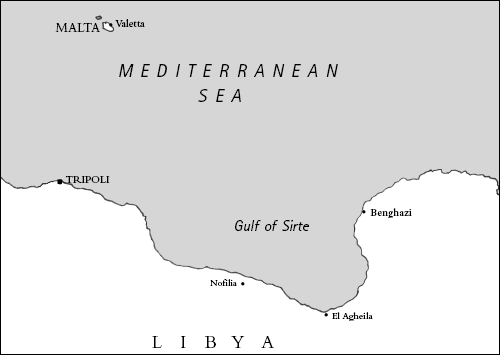
After the second battle of El Alamein in October 1942, the Allies pursued the Germans and Italians along the Libyan coast
When the offensive opened in mid-January 1943, resistance was limited because the Axis high command had already accepted that the stand should be made further east at the Mareth Line on the Tunisia–Libya border. Eighth Army reached Tripoli on 22 January 1943, and sappers and the navy soon cleared the devastated port. Troops from the division helped unload the ships carrying the supplies that 8 Army needed for its continued advance.
After taking part in blunting Rommel's counter-attack at Medenine on 6 March — his last action of the campaign — the New Zealanders prepared to join the Allied assault on the Mareth Line. By reaching the Tebaga Gap, they would threaten with encirclement Axis forces fighting Montgomery's main forces on the Mareth Line. Freyberg did not press home the assault immediately when they arrived at the Gap, and an opportunity was lost. Rapid deployments by the opposing forces then reinforced his caution. The deadlock was finally broken with a carefully planned and well-executed attack in the late afternoon of 26 March — Operation Supercharge II — that shattered the enemy position.
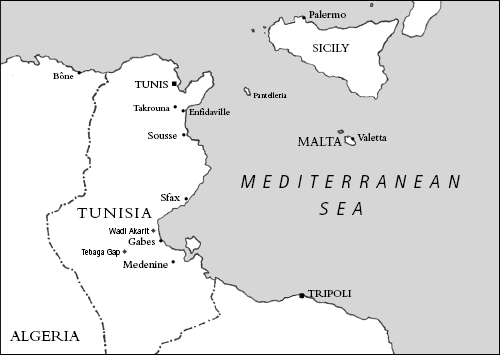
From Tripoli the Allies advanced into Tunisia where they successfully attacked the Germans and Italians at Tebaga Gap at the end of March 1943
The attack failed to trap the Axis forces on the Mareth Line. They retreated into a relatively small area of Tunisia, and the Allies planned an all-out offensive. The New Zealand Division attacked the area west of Enfidaville with two brigades. 6 Brigade, on the right, achieved its objectives without too much difficulty. On the left, however, 5 Brigade suffered heavy casualties as it pushed forward in an area dominated by Takrouna, a bald outcrop of rock rising steeply from the plain at the end of a ridge. Troops from the Maori and other battalions managed to get onto Takrouna and eventually prevailed after an epic fight.
Victory
Tthe terrain made it impossible for 8 Army to push very far north. By the time the end came on 13 May 1943, more than 200,000 Germans and Italians had laid down their arms. The commander of 1 Italian Army, Marshal Giovanni Messe, and the commander of the German 164 Light Division, Major-General Kurt von Liebenstein, surrendered to Freyberg.
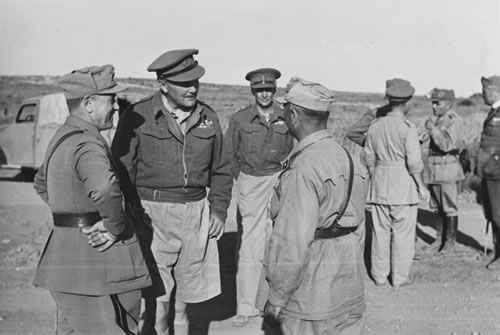
General Freyberg talking with Marshall Giovanni Messe after the Italian surrender in May 1943.
Alexander Turnbull Library, War History Collection, PAColl-5547-042
Hitler's belated decision to throw huge resources into holding Tunisia greatly magnified the cost of defeat in North Africa for the Axis, even if those forces had extended the campaign by four or five months. Had Rommel been given these resources in July 1942 he might well have been victorious.
The New Zealanders did not have long to savour the victory in Tunisia. On 15 May the first units began the long trek back to their base in Egypt, reflecting on battles fought and comrades lost. The last of the division reached Cairo on 1 June, cramming into Maadi and Helwan and settling down to await their next assignment. For 6000 of the longest-serving men, there was the prospect of an early return to New Zealand: they learned that they would go home on a three-month furlough.
Ian McGibbon
From Megan Hutching (ed.), The Desert Road: New Zealanders Remember the North African Campaign, Auckland, HarperCollins NZ, 2005
Next: Timeline >
